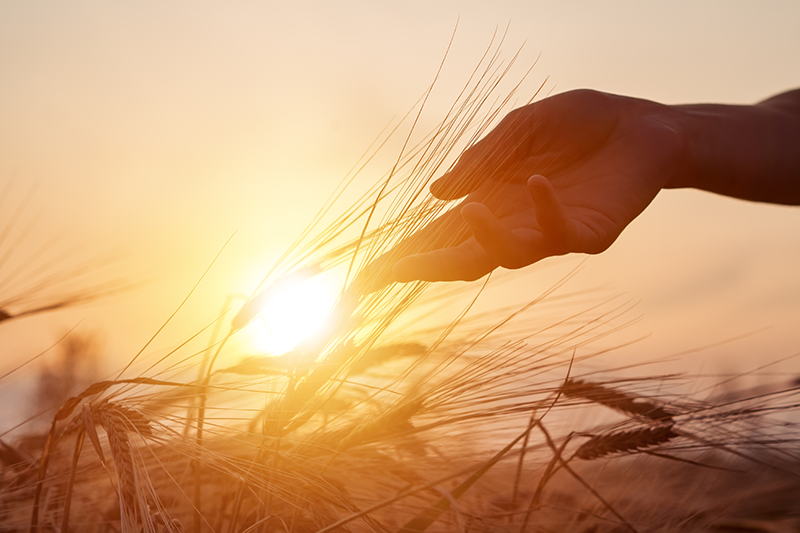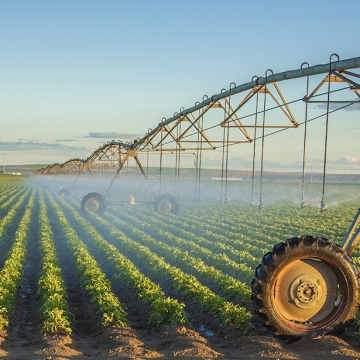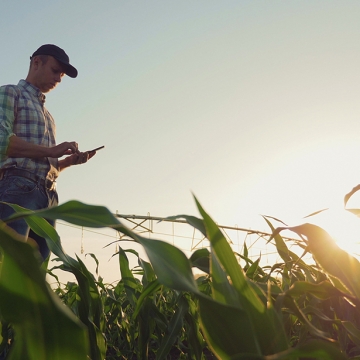Environment
Sustainable long-term solutions in a fast-changing world
Agriculture, ecosystems, and the environment are a balance of managing and dealing with the interface between agroecosystems and the natural environment, specifically how agriculture influences the environment and how changes in that environment impact agroecosystems.
Agriculture and climate change have a reciprocal relationship. Climate change affects agricultural production through precipitation levels and temperature variations
In all ecosystems, the biodiversity held in soil is massive. Healthy soils are vital to creating ample food production. Although agriculture is not the sole cause of soil degradation, adverse practices are known to cause a considerable decline in in the quality of soil. This mainly results from pesticide contamination, waterlogging, and salting. The degradation of the soil science leads to loss of soil fertility and structure. Australian farming enterprises are leading the world in many areas of production, implementing cutting edge technology to create diverse Agri-ecosystems and an understanding that a farm is virtually a living organism. Farmers are fast becoming leaders in the understanding the requirements of environmental science and creating diverse business models around healthy sustainable food productions systems, in often adverse conditions. The constant ability, adaptability, resilience, knowledge, and experience of Farming enterprises to produce food commodities in an often changing and challenging environment, including a financial environment, is truly remarkable. This is turn creates some of the most astute and insightful business managers in Agribusiness….or any business for that matter !
INVESTMENT
There has never been a better time to invest in mainstream Agriculture, Agribusiness, Agricultural projects to build a sustainable long-term investment portfolio. Investing into farming and agribusiness enterprises that have sound management and prudent economical strategies, will create safe reliable financial investment outcomes. Mainstream Agriculture is a safe long-term viable investment option that has many rewards, not only from a financial position but also from a personal view. Agriculture does not involve the farming enterprise but also the community. Modern agriculture and agribusiness have shifted in recent years to become innovators, using and developing cutting edge technology to produce safe food and fibre commodities, while at the same time protecting farm eco systems and the environment.
The current cov19 financial situation presents many problems and issues, however for agriculture and agribusiness it presents many amazing opportunities. The world still needs to eat and trade. Agriculture is the link to a sustainable Global financial community , without it , the world stops.
The recent flurry of land and agribusiness sales around the world was a long time coming and will continue to grow over the next ten years, official figures show Agriculture outperforming a whole range of other investments, like bonds and the share market. “there is no other long-term investment better than agriculture.”
The Australian Bureau of Statistics shows grain farming performs the best, returning 15 per cent a year in combined cash and capital return, with dairy ,beef and lamb returns at 13 per cent on investments a year, followed by broadacre returns at an impressive 11 per cent a year.
(Agriculture) is very stable,” the Australian China Business Week in Sydney.
Australian agriculture’s top 25 per cent outperforming the All Ordinaries over 17-year period.
Even in the short-term, agriculture had performed well. If we go back to the (GFC) Global Financial Crisis Australian agriculture was rock solid, second only to cash. In lots of ways, agriculture does not suit a listed company that wants an annual dividend, but for patient capital, investors who are serious about taking a – highly profitable term position, there are very few asset classes that are better than agriculture. The current crisis will also be an opportunity for those astute investors to hedge their investment portfolios into tangible assets like agriculture and agribusiness.
Four pillars” for successful agricultural enterprises and farming.
Very good management
Capitalisation – making sure money is there when you need it
Economies of scale – you would expect funds and sophisticated investors to have money to get a large enough property
Location – the right rainfall, soil, near the market and access to logistics
Managing your investment from end to end. Including export to import. Using the most qualified managers. Now has never been a better time to invest in the acquisition of agricultural land, farms, and agribusiness.
Land Management
Land Management allows the farm or business owner to achieve maximum productivity while having the smallest impact on the environment and natural resources. Increases profits while at the same time lowering costs. Understanding a few basic principles will allow the farm or business owner to experience several benefits. There are many decisions to consider when formulating a Land Management Plan for your agricultural business. Some are complex and require attention to detail
As a large percentage of soils in Australia are a part of agricultural environments proactively managed by farmers, the land management practices they choose can have a crucial impact on the condition of Australia’s soils. The condition of soil contributes significantly to the quality of ecosystem services a specific environment can provide. Improving management practices can reduce soil loss through wind and water erosion, and slow rates of acidification and soil carbon decline.
The figure below shows the dramatic difference land management decisions can make to ground cover and soil loss through wind erosion. Land management choices such as overgrazing can lead to decreased levels of ground cover (the layer of plant matter and other biological crusts holding the soil in place), contributing to wind erosion and increased dust levels. As the area of bare ground increases, there is greater risk of wind removing soil particles (including soil carbon and nutrients) as dust. The loss of these soil particles contributes to the decline of soil resource condition by reducing topsoil depth and removing lighter particles which can include nutrients and soil carbon, as well as reducing air and water quality as lost soil particles contaminate these systems. In contrast, management practices that contribute to the retention of ground cover will lessen the risk of wind erosion and water erosion removing soil particles. The result is a maintenance or improvement in overall resource condition.
Effect of land management decisions on ground cover and soil loss through wind erosion
Livestock
Russia has one of the largest black angus herds in the world at nearly 500,000 head and Miratorg has set up mass production of marbled Black Angus beef in Russia – real beef that offers users the opportunity to cook the perfect steak. Miratorg has its own stud farm of Aberdeen Angus steers, with their characteristic black appearance. By keeping strict direct control over the production of their fodder and feeding regime, and by directly managing the professional meat processing operations using special high-tech facilities located in the Bryansk Region of Russia, as well as the experience and input of top Russian and international experts in beef production and culinary matters, Miratorg is able to produce superlative-quality Black Angus marbled beef.
A round of Western sanctions on the Russian economy designed to impede the economy appear to have backfired when it comes to domestic agriculture. The article, which can be found here, suggests the uptick in agricultural activity is the result of irony as US company Miratorg has increased its presence in the country.
The US firms expertise in meat production has led it to purchase around 2 million acres of arable land and has increased the number of staff four-fold since 2010. It now employs 35,000 people.
Having secured generous state-backed loans, Miratorg has been importing everything from Aberdeen Angus cows, herding horses and even grass for the growing number of cattle to graze on.
The 1,000 +member team of homegrown Russian cowboys were initially trained by Americans, and are now overseeing a super-herd of almost 400,000 mother cows — making it one of the largest cattle operations in the world.
Ranch boss. Kansan Phil George, with over 25 years’ experience, has been hired to oversee the rapid expansion.
“When I first saw the land, all you could see was a landscape covered in a meter of snow. But we did things very, very quickly,” he said. “There was no infrastructure and no resources in Russia other than land and inexperienced people. We imported cattle, we imported 500 horses from the U.S, we bought saddles for every one of them, we imported semen, pharmaceuticals…even the first crails had to be imported and weren’t constructed here.” Mr George is quoted as saying.
Sanctions
The rapid expansion is a result of Putin’s desire for the country to become self-sufficient for food in the next five years, and to grow food exports to China and the Gulf. This is part of a plan to help reduce the Russian economy’s dependence on oil and gas activity, diversifying the economy and forging greater ties with the east. This follows a deterioration of relations between Russia and the west in recent years.
Russia’s recent pivot into agriculture predates the U.S. and EU sanctions that followed Russia’s invasion of Ukraine, but their imposition turbo-charged the growth of a previously dormant industry. In a counter move sanctions placed on the West by Russia in 2014 banned the import of food, rendering more than half of the country’s meat, dairy and fish imports illegal. As a result, the Russian state-backed domestic producers of cheese, meat, fish, vegetables, and wheat. Firms, such as Miratorg, increased production several times over in just a couple of years. Almost $4 billion worth of Russian agriculture products has been produced as a result of sanctions, according to the Russian government.
While production in the agriculture sector has benefited from the sanctions, this has come at a cost to the wider Russian economy and Russian citizens.
“Yes, of course, output has increased. However, it all comes at a cost to Russian households,” economist Natalia Volchkova told VICE News. “Russia’s counter-sanctions shield these businesses from world competition. They can’t compete with real-world prices.”
However, even in the unlikely event of a reversal in Russian-Western relations, Volchkova says Russia’s burgeoning cowboys might not be the first to succumb to market forces.
“Miratorg, now that’s a good question,” she said. “If they are actually using international practices, they might ultimately manage to be competitive in normal conditions.”
News
Last week was a whirlwind of trip and event cancellations, movement of courses online, and the dusting off of emergency and contingency plans. This week is likely to bring more social-distancing and quarantining measures. The ultimate toll and impacts of the coronavirus are highly uncertain at present. Nonetheless, it might be useful to speculate a bit about impacts of coronavirus and the events surrounding it on food markets.
1. Grocery buying behavior. It has been fascinating to watch online, and in my own local grocery stores, which items consumers are choosing to stock-up on. The run on toilet paper, for example, seems on the surface of it, downright irrational. After all, COVID-19 does not cause digestive issues. As irrational as the initial movement to toilet paper may seem, it isn’t crazy for subsequent consumers to then stock up too. After all, it doesn’t take much for a reasonable person to see that if all other consumers are buying up all the toilet paper, that they’d better off getting theirs before none is left. There is a long and interesting economics literature on information cascades and herding behavior, which shows that even if you disagree with what other people are doing, it is sometimes sensible to go along with the crowd.
Much of the information we have at this point on which items are stocking-out is anecdotal, but there do seem to be some common trends in what I see in my own local stores and commentary online. For example, it seems many of the new plant-based burgers are being left behind while the rest of the meat case is being cleared (see here or here )open hyper link) . I was surprised to see in my own local store, that virtually all the beef was gone (except for a bit of ground beef), about half the pork was gone, and chicken was plentiful. This must say something about people’s psychology to go for the highest-price, perishable produce in this time of panic; that or differences in supply chain issues, but more on that later. In other aisles, rice and pasta went quickly, presumably for issues related to the long shelf life, should quarantining result. Still, I noticed what was left in those aisles were the gluten-free options and the lesser-known brands or unusual flavours, suggesting stock-outs are related to item popularity. I hope we can learn more about this behaviour after the fact. Unfortunately, it’s difficult to study stocking-out phenomenon because stores are usually well stocked, and because grocery store scanner data only shows us what people bought, but we can’t see what people didn’t buy because it wasn’t available.



